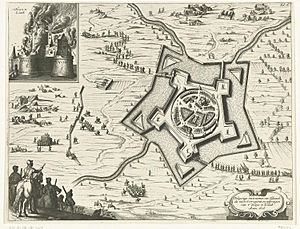Siege of Oldenzaal (1626) facts for kids
Quick facts for kids Siege of Oldenzaal (1626) |
|||||||
|---|---|---|---|---|---|---|---|
| Part of the Eighty Years' War and the Anglo–Spanish War | |||||||
 Capture of Oldenzaal 1626 |
|||||||
|
|||||||
| Belligerents | |||||||
| Commanders and leaders | |||||||
| Strength | |||||||
| 7,000 infantry and cavalry | 800 | ||||||
| Casualties and losses | |||||||
| Unknown | All captured | ||||||
The Siege of Oldenzaal was an important battle. It happened in the town of Oldenzaal in the Twente region. This town was controlled by Spain at the time. The siege took place from July 23 to August 1, 1626. It was part of two bigger wars: the Eighty Years' War and the Anglo–Spanish War. After eight days of fighting, led by Ernest Casimir, the city surrendered. This meant the Dutch and English forces won.
Contents
The Battle for Oldenzaal
Why Oldenzaal Was Important
A Spanish general named Ambrogio Spinola had captured Oldenzaal in 1605. He also took Groenlo a year later. This meant the Spanish army controlled this area. They used it to launch attacks on other places. In May 1626, the Dutch decided they needed to remove the Spanish from this region for good.
They gathered two armies for this mission. These armies were led by Frederick Henry, Prince of Orange. A group of English soldiers also joined them. England was at war with Spain at this time. Oldenzaal had been made stronger over the years. By 1626, it had about 800 soldiers and cannons. The Spanish Governor, Guillermo Verdugo, was in charge of the city's defense.
The Siege Begins
On July 23, the Dutch and English armies surrounded Oldenzaal. They had a good view of the area around the town. Because of this, Ernest Casimir decided they didn't need to build a special wall. This wall, called a circumvallation line, would have protected them from other Spanish armies trying to help Oldenzaal.
Casimir's skilled engineers, called pioneers, dug long trenches. These trenches were part of the siege lines. They also set up large cannons, known as batteries, in good positions. A few English companies were sent to attack Broeckhuise castle. This castle was on the edge of town and could have been a threat. The English captured it within two days. Dutch soldiers then looted and burned the castle.
Draining the Canals
Oldenzaal had canals that protected it. These canals were controlled by two special gates called sluice gates. Casimir ordered his cannons to fire at these gates. Eventually, the gates broke apart. The water from the canals then drained away. This left the city even more exposed.
The soldiers inside Oldenzaal were now cut off. Governor Verdugo realized that no help would come for them. After only ten days of cannon fire, he asked for terms to surrender. The siege ended honorably. Verdugo surrendered the city. His soldiers were allowed to march out with the "honors of war." This meant they could leave with their weapons and flags, showing respect.
What Happened After
Ernest Casimir entered Oldenzaal in triumph. Any Protestants who had sided with the Spanish were quickly arrested. Oldenzaal was a very important place for the Dutch Republic. The city's fortress walls were torn down. The people living in the city, called burghers, protested this. However, parts of the old medieval city walls and canals were kept. These were used to defend against any soldiers who might rebel. The next year, in 1627, the Dutch captured Groenlo. That siege lasted for two months.
See also
 In Spanish: Sitio de Oldenzaal (1626) para niños
In Spanish: Sitio de Oldenzaal (1626) para niños

